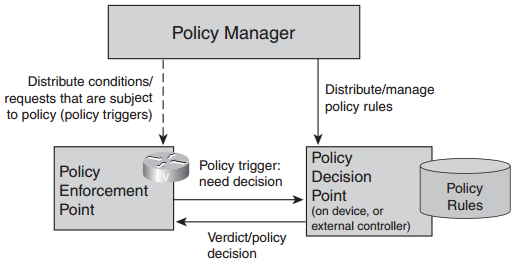Cisco Network Mgmt Protocol FAQ: Management Organization
Q1. Assume that you have to manage an enterprise network with several remote branch locations. You are told that you need to collect performance data from each remote location to assess the total traffic that goes to headquarters, that is directed to other enterprise locations, and that goes to destinations outside the enterprise. Your low-bandwidth WAN connection that leads back to your network operations center doesn’t seem to have enough bandwidth to allow for the export of all the Netflow data from the remote locations. What other options do you have?
Q2. What is RMON?
Q3. Give an example of a management task that a management appliance could provide.
Q4. If management by delegation is such a great idea, why don’t we simply delegate all management tasks to the network?
Q5. What do the acronyms PDP and PEP stand for?
Answer: Policy Decision Point and Policy Enforcement Point.
Figure: Policy-Based Management
Q6. How can policy-based management help scale management?
Q7. What are the main limitations of syntactical management mediation?
Q8. Why is stateful mediation more complex than stateless mediation?
Q9. Assume for a moment that you have two fictitious management protocols, SIMP and COMP. SIMP is a very simple protocol, providing only a small set of the most basic management primitives. COMP is much more powerful; it offers all the capabilities that SIMP offers, plus additional functionality. For example, COMP enables you to apply the same management operation to a group of managed objects that meet a certain criteria, and it offers a thresholdcrossing alerting capability, whereas SIMP does not. Now assume that you are asked to build two management gateways, one for SIMP managers to manage COMP agents, the other for COMP managers to manage SIMP agents. Which of the two do you expect to be simpler? Why?
Q10. Would you expect semantic mediation of management information that involves CLI as the source (agent) interface to be simple or hard? Why?
More Resources
